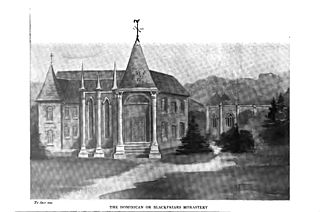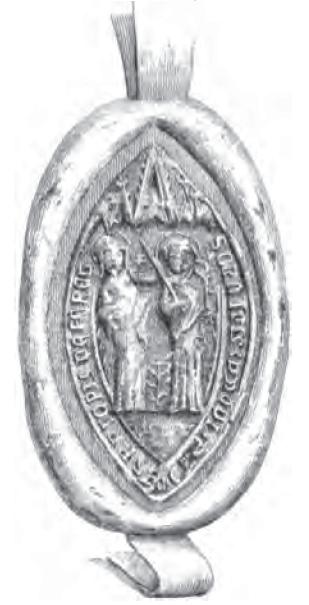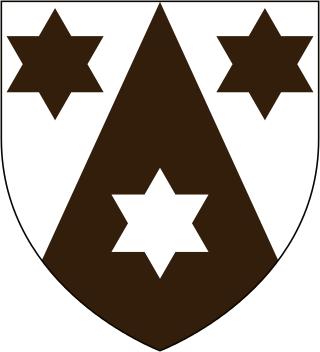Related Research Articles

The dissolution of the monasteries, occasionally referred to as the suppression of the monasteries, was the set of administrative and legal processes between 1536 and 1541, by which Henry VIII disbanded Catholic monasteries, priories, convents, and friaries in England, Wales, and Ireland; seized their wealth; disposed of their assets, and provided for their former personnel and functions.

A convent is an enclosed community of monks, nuns, friars or religious sisters. Alternatively, convent means the building used by the community.

The Minims, officially known as the Order of Minims, and known in German-speaking countries as the Paulaner Order, are a Roman Catholic religious order of friars founded by Francis of Paola in fifteenth-century Italy. The order soon spread to France, Germany and Spain, and continues to exist today.

Blackfriars is a restored Grade I listed 13th-century priory in Newcastle upon Tyne, Tyne and Wear, England, located in the city centre, close to the city's Chinatown.

The Church of the Friars Preachers of Blessed Virgin and Saint Dominic at Perth, commonly called "Blackfriars", was a mendicant friary of the Dominican Order of the Catholic Church founded in the 13th century at Perth, Scotland. The Dominicans were said by Walter Bower to have been brought to Scotland in 1230 by King Alexander II of Scotland, while John Spottiswood held that they were brought to Scotland by William de Malveisin, Bishop of St Andrews. Later tradition held that the Perth Dominican friary was founded by King Alexander II.
The Church of the Friars Preachers of the Annunciation of the Blessed Virgin Mary at Wigtown, commonly called Blackfriars, was a mendicant friary of the Dominican Order founded in the 13th century at Wigtown, Galloway, Scotland. The Chronica Extracta said that it was founded by Dervorguilla of Galloway, who died in 1290.
The Church of the Friars Preachers of St Laurence, Stirling, commonly called Blackfriars, was a mendicant friary of the Dominican Order founded in the 13th century at Stirling, Scotland.

Perth Charterhouse or Perth Priory, known in Latin as Domus Vallis Virtutis, was a monastic house of Carthusian monks based at Perth, Scotland. It was the only Carthusian house ever to be established in the Kingdom of Scotland, and one of the last non-mendicant houses to be founded in the kingdom. The traditional founding date of the house is 1429. Formal suppression of the house came in 1569, though this was not actualised until 1602.
Køge Friary was a small Franciscan friary located in Køge, on the east coast of Zealand, Denmark.
Holbaek Priory was a small Dominican monastery in Holbæk, Denmark.

Blackfriars is the modern name for the Dominican friary of St Mary which existed in St Andrews, Scotland, in the later Middle Ages. The name is also used for the modern ruins.

Greyfriars, in Bristol, England, was a Franciscan friary. The name Greyfriars derived from the grey robes worn by the friars. It was founded at some time before 1234, within the town walls and then moved to Lewin's Mead in 1250. The site included extensive gardens surrounded by a stone wall. Following the Dissolution of the Monasteries in the sixteenth century, the premises were leased to the town council in 1541, who desired to use the stone to make repairs to the town walls, and the harbour facilities. In succeeding centuries many different uses have been made of the site, which is currently occupied by an office block and part of Bristol Dental School.
Whitefriars was a Carmelite friary on the lower slopes of St Michael's Hill, Bristol, England. It was established in 1267; in subsequent centuries a friary church was built and extensive gardens developed. The establishment was dissolved in 1538.

Derby Dominican Priory, also known as Derby Black Friary, or Blackfriars, Derby, was a Dominican priory situated in the town of Derby, England. It was also named in different sources as a friary, monastery and convent, but was officially a priory as it was headed by a prior and the Dominican Order calls all their houses Priories. The "Black" came from the colour of the mantles worn by the friars of the order.

The buildings known as Whitefriars are the surviving fragments of a Carmelite friary founded in 1342 in Coventry, England. All that remains are the eastern cloister walk, a postern gateway in Much Park Street and the foundations of the friary church. It was initially home to a friary until the dissolution of the monasteries. During the 16th century it was owned by John Hales and served as King Henry VIII School, Coventry, before the school moved to St John's Hospital, Coventry. It was home to a workhouse during the 19th century. The buildings are currently used by Herbert Art Gallery and Museum, Coventry.

Austin Friars, London was an Augustinian friary in the City of London from its foundation, probably in the 1260s, until its dissolution in November 1538. It covered an area of about 5.5 acres a short distance to the north-east of the modern Bank of England and had a resident population of about 60 friars. A church stood at the centre of the friary precinct, with a complex of buildings behind it providing accommodation, refreshment and study space for the friars and visiting students. A large part of the friary precinct was occupied by gardens that provided vegetables, fruit and medicinal herbs.

The Augustinian Friary of the Most Holy Trinity was an Augustinian Roman Catholic Priory, founded c. 1259, by the family of Talbot on the south bank of the river, in what is now Crow Street, Dublin. At the time the priory was built, it was just outside the city walls. The Friary most likely followed the design of the parent priory Clare Priory in the town of Clare, Suffolk (England). The Friary was suppressed in 1540 when it was described as a "church with belfry, a hall and dormitory". The friars continued to operate in secret within the city. and there are several mentions of them in the city archives until the late 1700s when they consecrated a new church.

Nottingham Whitefriars is a former Carmelite monastery located in Nottingham, England.
Llanfaes Friary was a Franciscan friary in the now vanished medieval town of Llanfaes, close to what is now Beaumaris, in south east Anglesey, Wales. It was founded around 1237 in memory of Joan, wife of Llywelyn ab Iorwerth. The Friary survived the depopulation of the town, but was dissolved in 1538 and most of the buildings dismantled soon afterwards. The land became an estate on which, in 1623, Rowland Whyte built a house which he called Friars. It became one of the many properties of the Bulkeley family, and was substantially rebuilt in 1866. By the 20th century the house and grounds were owned by James Hartley Burton. In 1939 they were requisitioned for wartime use, adapting and repairing flying boats, by Saunders-Roe, who continued after the war with a wide variety of light engineering activities. The industrial uses finally came to an end in the late 1990s. An archaeological dig on the site in 1991 identified substantial buried remains of the friary church and other monastic buildings. The site is a Scheduled monument.
References
- Cowan, Ian B. & Easson, David E., Medieval Religious Houses: Scotland With an Appendix on the Houses in the Isle of Man, Second Edition, (London, 1976)